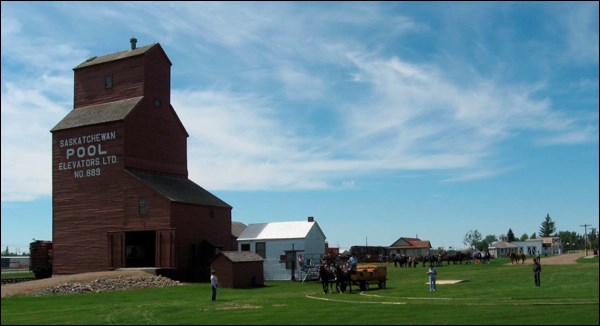Towering above the landscape, a beacon for prairie travellers, the grain elevator has come to symbolize the settlement of the Canadian West in the early years of the 20th century.
Intent on saving this quintessential symbol of prairie farm life, in 1983 the North Battleford Western Development Museum (WDM) masterminded the transfer of a Saskatchewan Wheat Pool elevator from the village of Keatley, 60 kilometres northeast of the Battlefords.
Fuelled by settlement, rail lines were built in a flurry in the early years of the 20th century. Elevators soon followed, every 12 to16 kilometres (eight to10 miles) or so down the line, based on the distance of a one-day journey from farm to rail.
Grain was the backbone of the fledgling prairie economy. Newcomers showed the prairie soil could grow grain; getting the grain to world markets was essential for sustained settlement. With the invention and adoption of the vertical leg elevator, hauling sacks of grain by horse and wagon to the nearest rail line was supplanted with grain delivered to the elevator.
From 1911 to the early 1990s, farmer-owned co-operatives dominated the Saskatchewan elevator story. The Saskatchewan Wheat Pool, a farmer-owned marketing co-operative, was created in 1924 and built its first elevator at Bulyea in 1925. The Pool went on to build or buy hundreds of country elevators in Saskatchewan. Built in 1928, the 23-metre (75-foot) wooden crib Wheat Pool elevator 889 dominated the Keatley horizon for years.
To settle a dispute over lot placement, the Wheat Pool boldly constructed elevator 889 in just three weeks. A crew of 18 men with saws, hammers and loads of lumber swarmed the lot and erected the wooden crib elevator. The structure consisted of the elevator, the driveway and the office/engine room.
First the crew laid the cement foundation. Then they started on the walls. Because grain is heavy, the elevator had to be built to withstand the pressure of a full load of grain pressing against bin walls. Wood crib construction used two-by-sixes or two-by-eights spiked together on the lower walls. Upper walls used two-by-fours. Once framed, the crew nailed wood siding over the exterior. The crew's last job was to paint the elevator. Construction cost in 1928 was $14,000. The painting cost in 2012 will rival the entire construction and painting in 1928 values.
In 1905, there were 298 grain elevators in Saskatchewan. By 1925, that had skyrocketed to 2,552 elevators. The number of grain elevators in Saskatchewan peaked at 3,240 in 1932-22. During Saskatchewan's Jubilee year in 1955, the number had decreased marginally to 2,957.
Once rising regularly above the prairie horizon, prairie grain elevators are disappearing as times in Saskatchewan change. In the Depression years of the 1930s, falling farm incomes led to the first wave of rural depopulation. In the heyday of the 1950s, improved roads, mechanized farm equipment and optimistic expectations accelerated the decline in farm numbers. As farms grew in size, the rural population did not.
For a while the rail network and the elevator system remained stable until, during the 1960s, the system began to break down. As farms grew larger and larger, many of the small branch lines like Keatley's could no longer operate at a profit. In 1969 the Canadian government passed new legislation that allowed grain to be hauled in trucks and semi-trailers. In 1977, the Hall Commission recommended abandoning many kilometers of the prairie rail network.
Amalgamations within the grain industry intensified. Deregulation and the demise of the Crow Rate in 1996 contributed to the abandonment of even major rail lines and a further reduction in the number of grain elevators. Each progressive trend was a nail in the coffin for the rows of country elevators in Saskatchewan.
The Keatley elevator 889 was a gift to the WDM from the Saskatchewan Wheat Pool. Forty power lines had to be cut along the route of the move. With an eye on history, 30 SaskPower staff volunteered to assist with the move.
Today this rugged symbol of the prairie needs help. Prairie wind, rain, sun and snow have faded, blistered and peeled its paint. The price of elevator paint has risen dramatically from the $4 per gallon paid in 1928. Painting the structure is a mammoth task, yet it needs to be done soon. Support from the Battlefords community will ensure a new coat of paint and a new lease on life for a structure of significance to the story of Saskatchewan.




